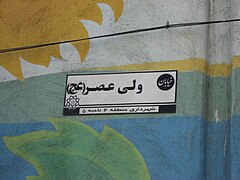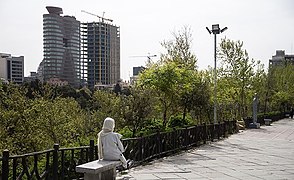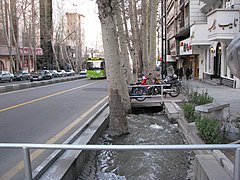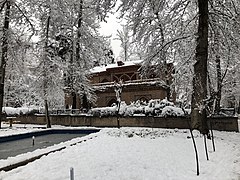Valiasr Street
 | |
 | |
| Length | 17.9 km (11.1 mi) |
|---|---|
| Location | Tehran |
| From | |
| To | |
35°43′58″N 51°24′40″E / 35.732826°N 51.411112°EValiasr Street (Persian: خیابان ولیعصر),[1] formerly known as Pahlavi Street, is a tree-lined street in Tehran, dividing the metropolis into western and eastern parts which were built in 1922 to 1927 respectively, considering the end of asphalt plan it ended in 1933. It is considered one of Tehran's main thoroughfares and commercial centers. It is also the longest street in the Middle East,[2][3] and was reported as one of the longest in the world by former BBC (now Al Jazeera) journalist Rageh Omaar during the television documentary Welcome to Tehran.[4]
The street was built by Reza Pahlavi's order and called the Pahlavi Street. After the Iranian Revolution the street's name was changed initially to Mossadeq Street (in reference to the former nationalist prime minister Mohammad Mossadegh) and later to Valiasr. This vibrant, hub-like street is lined with many shops, restaurants, parks, and cultural centers situated along this long avenue.
History
[edit]The construction of Valiasr Street dates back to the era of Minister Reza Pahlavi during the Qajar era. Almost a hundred years ago, He began buying land, such as parts of Behjat Abad in Shemiran (a district in central Tehran). Later, he bought the palace belonging to the daughter of Naser al-Din Shah Qajar. At the same time, Reza Pahlavi had begun constructing a street in Shemiranat County in Tehran province to make access to the palaces in that area more efficient.
During the Qajar era, palaces were built on the North and South of the Capital by the Qajar shahs like Ahmad Shah Qajar. Because of the location of the Marble Palace (Marmar Palace) in Tehran, Reza Pahlavi decided to extend the route leading to the palaces in the Northern part of Tehran heading to the Marble Palace. When he sat on the throne, Reza named this route “Pahlavi.”
Therefore, before the Iranian Revolution of Iran, Vali-e Asr Street was called Pahlavi Street, which was named after the Pahlavi dynasty. Previously, the route was a minor dirt road for local crossings.
From then on, the renowned Valiasr Street started its formation, and in the initial stages of the construction, planting Plane trees and building a stream also began on this route. Seven years later, Tehran municipality paved this street. In 1930, asphalting was introduced in Tehran's urban development system, and a year later, Valiasr Street was asphalted.
In 1938, a rose bush was planted on both sides of Valiasr Street, two meters apart, and between two saplings, and two wells were dug in Zafaraniyeh, which is now an upmarket neighborhood in Tehran, for irrigating these newly planted trees.
As mentioned earlier, the street was only for the use of government officials. However, from 1940 onwards, access to Pahlavi Street was made possible for ordinary people. With the presence of some neighboring allies in Iran and their entry into the Pahlavi Street, the route was then made permissible for the general public, and people were able to walk around the Behjat Abad gardens.[5]
Environmental concerns
[edit]The plane trees of Valiasr Street have always been a major element of the street's identity and one of Tehran's irreplaceable landmarks. After the Iranian Revolution, due to severe mismanagement, the living conditions of the trees have been constantly deteriorated causing immense public concerns. The number of trees were decreased from 24,000 in 1946 to 12,000 in 1995. In 2012 only 8,288 trees were left. The main contributing issues are including but not limited to:
- destruction of natural waterflow networks such as rivers and springs;
- irregular watering;
- water contamination;
- soil contamination;
- damages to the roots of the trees by the increased population of the rats, poor curbing, pouring concrete foundation for construction projects;
- soil erosion and exposure of the tree roots to the air;
- mistreatment of the trees by humans;
- air pollution;
- lack of sunlight exposure due to high-rise building. [6]
In only one of several incidents, in July 2022, a property owner intentionally poisoned 13 trees just for a better visibility of the building's façade.[7]
It was reported in 2023 that 179 trees on the street would be cut down and replaced.[8] The concern for the trees of Valiasr Street is reflected in the Grammy Award winning song Baraye.
Shopping
[edit]Valiasr Avenue is the main Shopping street in Tehran and the whole of Iran. Many foreign chain stores have branches on this street like Benetton Group (three stores), Reebok, Adidas, etc. Many important shopping centers of Tehran are located on Valiasr street like the Tandis Center (located at the northeast point of the street at Tajrish Sq.), the Safavieh Mall,[9] the Eskan Shopping center and many more. Many luxury jewelry and accessories stores such as Rolex and Tag Heuer are located on this street. Furthermore, hundreds of other local stores are located at Valiasr.
Other
[edit]- Many cinemas, restaurants, and hotels are located on this street.
- Tehran City Theatre
- Mellat Park and Saéi Park (two of Tehran's most visited parks)
- Jomhori Intersection Grand Bazzar
- Cinema museum
- Central building of the Iranian Red Crescent Organization
- Valiasr hospital
- Shahid rajaie Research-Therapeutic-Medical Center
Location
[edit]Valiasr runs from Tehran's railway station (1,117 metres (3,665 ft) elevation above sea level) in the south of the city to the Tajrish square (1,612 metres (5,289 ft) elevation above sea level) in the north.
Valiasr runs for 12 miles (19.3 kilometers), north to south, and is filled with traffic at all hours, even until the early hours of the morning. The shops stay open late and the kiosks sell fresh fruit juice, coffee and newspapers.
Gallery
[edit]-
Street sign
-
Street near Vanak
-
Near Saei Park
-
Side walk after Valiasr square
-
Street in spring
-
Lighting of street trees
-
Second step
-
A store at the street
-
Valiasr Underpass
-
Ghalamestan Park in a snowy day
-
Street in the evening
-
Valiasr street from City Theater of Tehran
See also
[edit]References
[edit]- ^ Karber, Phil (18 June 2012). Fear and Faith in Paradise: Exploring Conflict and Religion in the Middle East. ISBN 9781442214798.
- ^ "'Death to the dictator' chants fuel Tehran riot". Brisbane Times. 2009-06-15. Retrieved 2009-09-04.
- ^ "Valiasr Street | The Longest Avenue in Middle East | Tehran Attraction". Apochi. Retrieved 2024-05-17.
- ^ "Welcome to Tehran – a journey by Rageh Omaar". BBC. 2006-11-03. Retrieved 2007-08-26.
- ^ "Valiasr Street in Tehran: Map, Trees, Photos, What to Do". Irandoostan. 2023-11-14. Retrieved 2023-11-14.
- ^ "'بررسی علل خشک شدن چنارهای خیابان ولیعصر و راهکارهای احیای آن ها". Civilica (in Persian). Retrieved 2023-02-08.
- ^ "$3.8m Fine for Intentional Drying of Trees of Pahlavi Street". Independent Persian. 2 August 2022. Retrieved 15 February 2023.
- ^ "شهرداری منطقه یک تهران: ۱۷۹ درخت در خیابان ولیعصر قطع خواهند شد". ایران اینترنشنال (in Persian). 2023-09-10. Retrieved 2023-09-10.
- ^ "about the shopping center".













